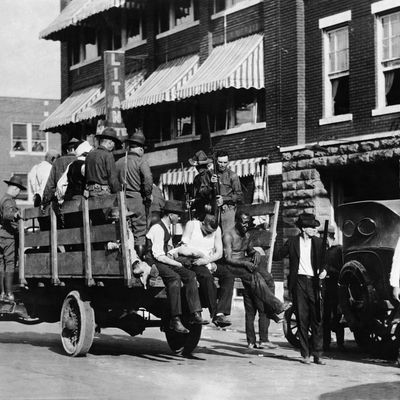
Oklahoma’s Education Department is adding the 1921 Tulsa race massacre to its curriculum for the first time, in a move that doubles as a contingency to stop the tragedy’s centennial from devolving into a pile-on of the state’s failure to fully reckon with the tragedy. CNN reports that the decision was announced on Wednesday, with State Senator Kevin Matthews describing the 99-year-old killings as “Tulsa’s dirty secret.” Students from elementary through high school will be required to learn about them starting this fall. A pilot program run by Tulsa Public Schools has provided the blueprint for how the incident will be taught, and helped administrators develop tools and resources to ensure that teachers are comfortable teaching it. Until now, lessons about the massacre have been inconsistent — some schools taught it, some didn’t. Its universalization this week marks something of a turnaround in how its centrality to Oklahoma’s history is understood there.
It’s also not the only related effort. Last year, Tulsa mayor G.T. Bynum, a Republican, had a team of scientists and forensic anthropologists investigate a structural anomaly in the Oaklawn Cemetery, located a few blocks from Tulsa’s Greenwood District, which was known colloquially in the early 20th century as “Black Wall Street.” The anomaly was first discovered in the late 1990s and seemed to indicate the presence of a mass grave. “We owe it to the community to determine if there are mass graves in our city,” Bynum said, according to the Washington Post. “We owe it to the victims and their family members.” Earlier this month, officials agreed to permit “limited excavations” in the cemetery to determine whether the anomaly contains the bodies of people killed in 1921. They clarified that there are no current plans to exhume the researchers’ findings. Taken in tandem, the curricular overhaul and mass-grave search seem to comprise an overdue deference on the part of local officials to an event whose magnitude and devastation had long been underappreciated.
The broad strokes of what happened in Tulsa in 1921 are perhaps more widely known today than ever before, owing in part to a fictionalized depiction of the tragedy in HBO’s Watchmen series. It commenced on May 31 of that year, when rumors circulated that a black man named Dick Rowland had sexually assaulted a white woman, Sarah Page, in an elevator. The allegations catalyzed what’s widely understood as a broader set of interracial resentments — namely those of Tulsa’s white residents toward the black denizens of Greenwood, a thriving business district marked by an unusual concentration of black wealth. Whites lay siege to the area, cordoning off its borders so that black people had trouble evacuating and shooting those they’d trapped. They set fire to around 40 blocks of homes and businesses, torching buildings from the ground while using airplanes to firebomb Greenwood from the sky. Forty-eight hours later, more than 300 black people were dead and 10,000 more were left homeless.
Though efforts to revitalize the Greenwood District over the subsequent century have come in spurts, of late they’ve been widely criticized for directing the spoils of redevelopment away from those who should benefit the most. From the Post:
[As] Tulsa prepares to commemorate the massacre’s centennial in 2021, a community still haunted by its history is being transformed by a wave of new development in and around Greenwood.
There’s a minor-league baseball stadium and plans for a BMX motocross headquarters. There’s an arts district marketed to millennials, and a hip shopping complex constructed out of empty shipping containers. There’s a high-end apartment complex with a yoga studio and pub.
While almost two-thirds of the neighborhood’s residents are African American, the gentrification has surfaced tensions between the present and the past.
This “tension” hints at a common dynamic that often complicates such historical commemorations — that the sincerity and reverence with which they’re pursued by some is, in as many ways, offset by their parallel function as a sort of capital-driven “boosterism,” to quote Rhodes College professor and lifelong Memphian Zandria Robinson, designed to remake their locations’ sullied image to appeal to potential investors. One can only hope that Oklahoma’s broadening education around the 1921 massacre, as indicated by its inclusion in the state curriculum, will produce minds better equipped to reckon with and offset it than previous generations have been.





























